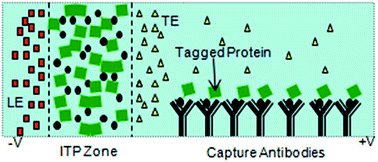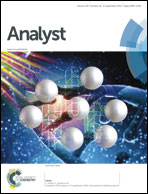Increasing the sensitivity of microfluidics based immunoassays using isotachophoresis†
Abstract
We have developed a microfluidic device that enhances the sensitivity of protein immunoassays by preconcentrating the protein sample using isotachophoresis (ITP). Two approaches were followed to study the sensitivity gain achieved that way. The first approach was using antibody-coated magnetic beads loaded into a microchannel to capture the proteins within the ITP sample zone. The second was to directly bind the antibodies to the microchannel surface. The use of ITP increased the sensitivity of both the direct and the bead-based immunoassay and lowered the model protein's detection limit. Our setup also uses electrokinetic injection for sample charging, thereby sparing the need for integrating mechanical components such as pumps or valves and reducing the complexity of the setup. This work demonstrates the feasibility of using ITP as a preconcentration mechanism of proteins in immunoassays. The protein was concentrated by a factor of 100 and the assay's limit of detection was in the picomolar range. ITP can be applied to any sample of mixed content, separating and preconcentrating the desired analyte before it reaches the detection region with immobilized antibodies, without the need for separating and concentrating the sample in an independent step.


 Please wait while we load your content...
Please wait while we load your content...